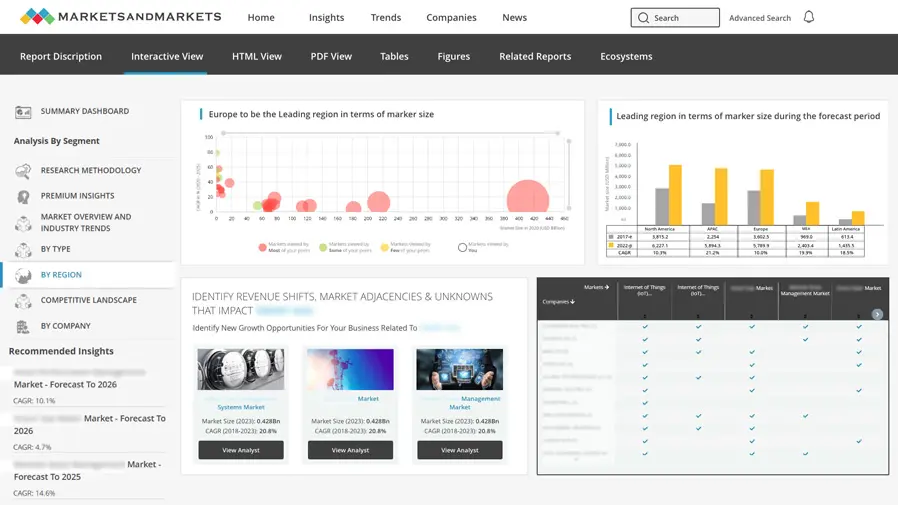TABLE OF CONTENTS
1 Introduction
1.1. Study Objectives
1.2. Market Definition and Scope
1.2.1. Inclusions and Exclusions
1.3. Study Scope
1.3.1. Markets Covered
1.3.2. Geographic Segmentation
1.3.3. Years Considered for the study
1.4. Currency
1.5. Limitations
1.6. Stakeholders
2 Research Methodology
2.1. Research Data
2.1.1. Secondary Data
2.1.1.1. Major Secondary Sources
2.1.1.2. Key Data from Secondary Sources
2.1.2. Primary Data
2.1.2.1. Primary Interviews with Experts
2.1.2.2. Key Data from Primary Sources
2.1.2.3. Key Industry Insights
2.1.2.4. Breakdown of Primaries
2.2. Market Size Estimation
2.2.1. Bottom-Up Approach
2.2.1.1. Approach for Capturing Market Share by Bottom-Up Analysis (Demand Side)
2.2.2. Top-Down Approach
2.2.2.1. Approach for Capturing Market Share by Top-Down Analysis (Supply Side)
2.3. Market Breakdown and Data Triangulation
2.4. Research Assumptions
2.5. Risk Assessment
2.6. Assumptions of Recession
2.7. Limitations of Research
3 Executive Summary
4 Premium Insights
5 Market Overview
5.1. Introduction
5.2. Market Dynamics
5.3. Trends/Disruptions Impacting Customer’s Business
5.4. Pricing Analysis
5.4.1. Average Selling Price Trend of Key Players, By Product Type
5.4.2. Average Selling Price Trend, By Region
5.5. Value Chain Analysis
5.6. Ecosystem Analysis
5.7. Investment and Funding Scenario
5.8. Funding, By Application
5.9. Technology Analysis
5.9.1. Key Technologies
5.9.1.1. Artificial Intelligence
5.9.2. Complementary Technologies
5.9.2.1. Cloud Computing
5.9.3. Adjacent Technologies
5.9.3.1. Motion Sensors
5.10. Patent Analysis
5.11. Trade Analysis
5.12. Key Conferences and Events (2025-2026)
5.13. Case Study Analysis
5.14. Tariff and Regulatory Landscape
5.14.1. Regulatory Bodies, Government Agencies, and Other Organizations
5.14.2. Key Regulations
5.15. Porters Five Force Analysis
5.15.1. Threat from New Entrants
5.15.2. Threat of Substitutes
5.15.3. Bargaining Power of Suppliers
5.15.4. Bargaining Power of Buyers
5.15.5. Intensity of Competitive Rivalry
5.16. Key Stakeholders and Buying Criteria
5.16.1. Key Stakeholders in Buying Process
5.16.2. Buying Criteria
5.17. Impact of AI on Network Infrastructure Solutions Market
6 Network Infrastructure Solutions Market, By Type
6.1. Introduction
6.2. Enterprise Network Infrastructure
6.3. Service Provider Network Infrastructure
7 Network Infrastructure Solutions Market, By Component
7.1. Introduction
7.2. Hardware
7.2.1. Routers
7.2.2. Switches
7.2.3. Wireless Access Points
7.2.4. Firewalls
7.2.5. Other Networking Devices
7.3. Software
7.3.1. Network Management Software
7.3.2. Virtualization Software
7.3.3. Security Software
7.4. Services
7.4.1. Professional
7.4.2. Managed
8 Network Infrastructure Solutions Market, By Deployment Mode
8.1. Introduction
8.2. On-premises
8.3. Cloud-based
8.4. Hybrid
9 Network Infrastructure Solutions Market, By Organization Size
9.1. Introduction
9.2. SMEs
9.3. Large Enterprises
10 Network Infrastructure Solutions Market, By Application
10.1. Introduction
10.2. System Management
10.3. Network Security
10.4. Data Storage and Management
10.5. Communication and Collaboration
10.6. Computing
10.7. Other Applications
11 Network Infrastructure Solutions Market, By End User
11.1. Introduction
11.2. IT and Telecommunications
11.3. BFSI
11.4. Healthcare
11.5. Manufacturing
11.6. Government
11.7. Others
12 Network Infrastructure Solutions Market, By Region
12.1. Introduction
12.2. North America
12.2.1. Macro-Economic Outlook
12.2.2. US
12.2.3. Canada
12.2.4. Mexico
12.3. Europe
12.3.1. Macro-Economic Outlook
12.3.2. UK
12.3.3. Germany
12.3.4. France
12.3.5. Italy
12.3.6. Rest of Europe
12.4. Asia Pacific
12.4.1. Macro-Economic Outlook
12.4.2. China
12.4.3. Japan
12.4.4. South Korea
12.4.5. India
12.4.6. Rest of Asia Pacific
12.5. RoW
12.5.1. Macro-Economic Outlook
12.5.2. Middle East
12.5.2.1. GCC Countries
12.5.2.2. Rest of Middle East
12.5.3. Africa
12.5.4. South America
13 Network Infrastructure Solutions Market, Competitive Landscape
13.1. Revenue Analysis
13.2. Market Share Analysis
13.3. Company Valuation and Financial Metrics
13.4. Brand/Product Comparison
13.5. Company Evaluation Matrix: Key Players, 2024
13.5.1. Stars
13.5.2. Emerging Leaders
13.5.3. Pervasive Players
13.5.4. Participants
13.5.5. Company Footprint: Key Players, 2024
13.6. Company Evaluation Matrix: Startups/SMEs, 2024
13.6.1. Progressive Companies
13.6.2. Responsive Companies
13.6.3. Dynamic Companies
13.6.4. Starting Blocks
13.6.5. Competitive Benchmarking: Startups/SMEs, 2024
13.6.5.1. Detailed List of Key Startups/SMEs
13.6.5.2. Competitive Benchmarking of Key Startups/SMEs
13.7. Competitive Situation and Trends
14 Network Infrastructure Solutions Market, Company Profiles
14.1. Key Players
14.1.1. Broadcomm
14.1.2. Cisco Systems, Inc.
14.1.3. Ericsson
14.1.4. Fujitsu
14.1.5. Hewlett Packard Enterprise Development LP
14.1.6. Huawei Technologies
14.1.7. IBM
14.1.8. Juniper Networks, Inc.
14.1.9. NEC Corporation
14.1.10. Nokia
14.2. Other Players
15 Appendix
15.1. Discussion Guide
15.2. Knowledge Store: MarketsandMarkets’ Subscription Portal
15.3. Available Customizations
15.4. Related Reports
15.5. Author Details
Note 1: The above list of companies is tentative and might change during the due course of research.
Note 2: The current table of contents is tentative and is subject to change as we progress with our research.
















Growth opportunities and latent adjacency in Network Infrastructure Solutions Market